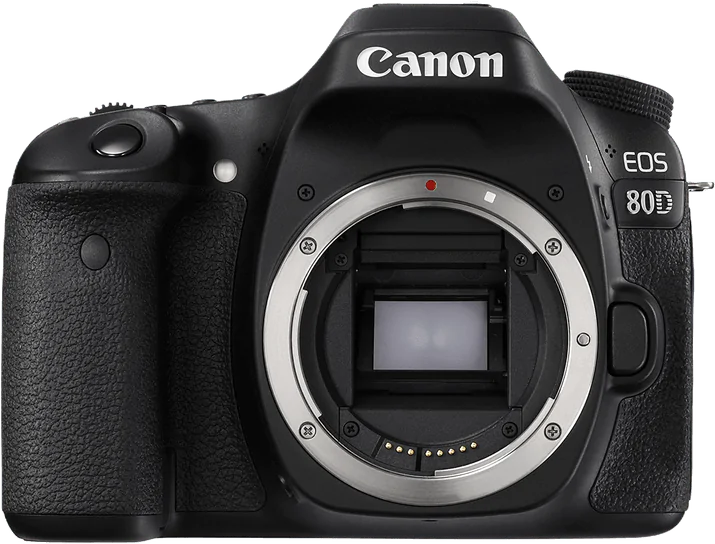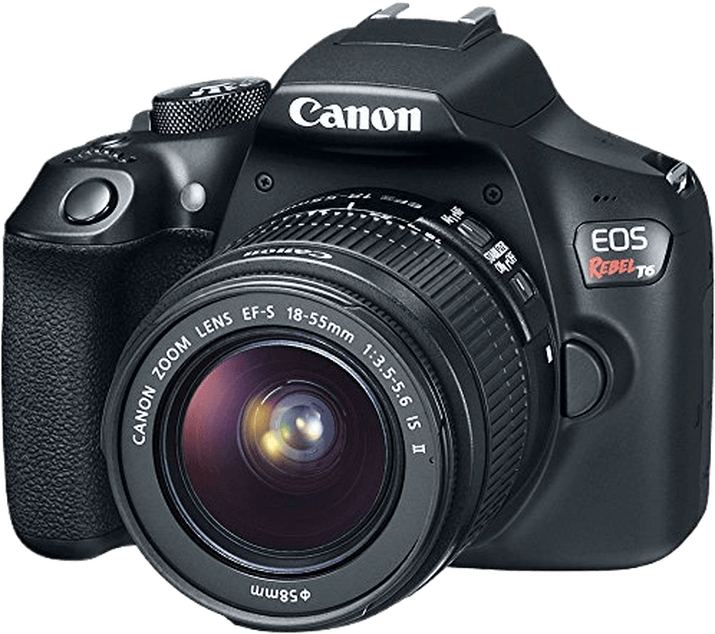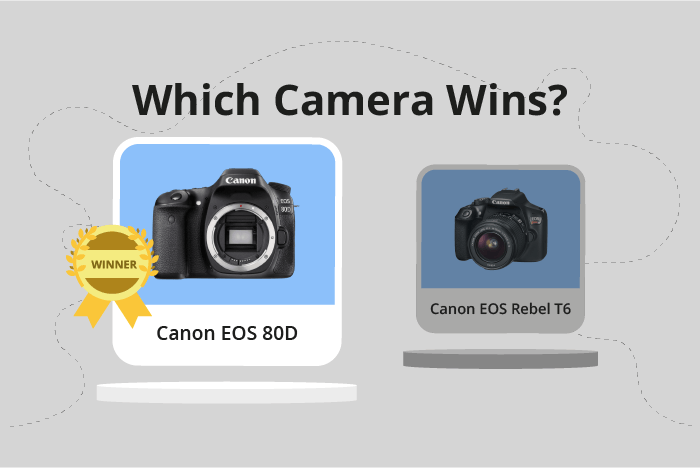Canon EOS 80D vs EOS Rebel T6 / 1300D Comparison
Canon EOS 80D

Canon EOS Rebel T6 / 1300D

The Canon EOS 80D outperforms the Canon EOS Rebel T6 / 1300D with a score of 64/100 compared to 39/100. Both cameras, launched in 2016, are DSLR types and share similar dimensions, with the 80D measuring 139 x 105 x 79mm and the Rebel T6 at 129 x 101 x 78mm. The 80D is better in terms of performance, but it comes with a higher launch price of $1200, while the Rebel T6 is more affordable at $550. The Rebel T6 has the advantage of being lighter, weighing 485g, compared to the 80D’s 730g.
Taking these factors into account, the Canon EOS 80D offers superior performance and features, justifying its higher price. The Canon EOS Rebel T6 / 1300D, on the other hand, provides a more budget-friendly option while still offering decent quality and functionality.
Canon EOS 80D vs EOS Rebel T6 / 1300D Overview and Optics
The Canon EOS 80D triumphs over the Canon EOS Rebel T6 / 1300D in optics with a score of 63/100, a 23-point lead over the Rebel T6’s 40/100. Both cameras share certain specifications, such as the CMOS sensor type, APS-C sensor size, Canon EF-S lens mount, and the lack of image stabilization.
The EOS 80D outperforms the Rebel T6 in several aspects. It boasts a higher resolution of 24.2 megapixels, compared to the T6’s 18 megapixels, allowing for more detailed images. The 80D also has a faster shooting speed of 7 frames per second (fps), making it more suitable for capturing fast-moving subjects. Its Digic 6 processor contributes to better image processing and overall camera performance. Additionally, the 80D has a higher DXOMARK sensor score of 79, indicating superior image quality and low-light performance.
On the other hand, the Rebel T6 has a lower score in all mentioned criteria, with 18 megapixels, a shooting speed of 3 fps, a Digic 4+ processor, and a DXOMARK sensor score of 66. While it may not excel in these specific areas, the T6 may still be a viable option for entry-level photographers or those on a budget.
Taking these factors into account, the Canon EOS 80D is the clear winner in optical performance. Its higher resolution, faster shooting speed, and better image quality make it a more versatile and capable camera. The Rebel T6, however, can still serve as a suitable choice for photographers who prioritize affordability and ease of use.
Canon EOS 80D vs EOS Rebel T6 / 1300D Video Performance
The Canon EOS 80D outperforms the Canon EOS Rebel T6 / 1300D in video capabilities with a score of 70/100 compared to 43/100. Both cameras share Full HD video resolution and 1920 x 1080 max video dimensions, providing high-quality footage in either model.
The EOS 80D holds a substantial advantage with a max video frame rate of 60fps, double that of the Rebel T6 / 1300D’s 30fps. This higher frame rate enables smoother, more professional-looking videos, making the 80D a better choice for those prioritizing video quality. Additionally, the 80D has built-in time-lapse functionality, which the Rebel T6 / 1300D lacks. This feature further enhances the 80D’s video capabilities, allowing for creative and dynamic time-lapse sequences.
While the Rebel T6 / 1300D falls short in these areas, it still offers Full HD video resolution and decent max video dimensions. For casual users or those primarily focused on photography, the Rebel T6 / 1300D may still be a suitable choice, especially considering its lower price point.
Taking these factors into account, the Canon EOS 80D is the clear winner for those seeking superior video performance. With a higher video score, faster frame rate, and time-lapse functionality, it outshines the Rebel T6 / 1300D. However, the Rebel T6 / 1300D remains a viable option for those with budget constraints or less emphasis on video capabilities, still providing Full HD resolution and satisfactory video dimensions.
Canon EOS 80D vs EOS Rebel T6 / 1300D Features and Benefits
The Canon EOS 80D outperforms the Canon EOS Rebel T6 / 1300D in features, scoring 70/100 compared to the Rebel T6’s 41/100. Both cameras share some common specifications, such as a 3-inch screen size, no GPS, and WIFI connectivity. However, the 80D has distinct advantages over the Rebel T6, while the latter has few areas where it surpasses the 80D.
The 80D boasts a higher screen resolution of 1,040,000 dots, compared to the Rebel T6’s 920,000 dots. This difference provides clearer and more detailed image previews on the 80D’s screen. Additionally, the 80D features a touchscreen, making it more user-friendly and efficient in selecting focus points or navigating menus. The Rebel T6 lacks a touchscreen, relying on physical buttons for navigation.
While both cameras have flip screens, the 80D’s touchscreen adds to its superiority in this aspect. The Rebel T6 offers no significant advantages over the 80D in terms of features, with both lacking GPS and Bluetooth connectivity.
The Canon EOS 80D clearly surpasses the Rebel T6 / 1300D in features, providing a higher resolution screen and a touchscreen interface, making it a better choice for photographers seeking a more user-friendly and capable camera. The Rebel T6, although it shares some specifications with the 80D, falls short in comparison and does not offer any notable advantages.
Canon EOS 80D vs EOS Rebel T6 / 1300D Storage and Battery
The Canon EOS 80D outperforms the Canon EOS Rebel T6 / 1300D in storage and battery with a score of 43/100 compared to 27/100. Both cameras have a single memory card slot, accepting SD, SDHC, and SDXC cards. However, the 80D is UHS-I compatible, allowing for faster data transfer.
In terms of battery life, the 80D is superior with 960 shots per charge, whereas the T6 / 1300D offers only 500 shots. The 80D uses the LP-E6N battery type, while the T6 / 1300D uses the LP-E10. Neither camera supports USB charging.
Although the T6 / 1300D has a lower score, it shares essential storage features with the 80D. However, the 80D’s compatibility with UHS-I and longer battery life make it the better choice in this category. The T6 / 1300D does not offer any advantages in storage and battery over the 80D. Therefore, the Canon EOS 80D is the clear winner in terms of storage and battery performance.
Alternatives to the Canon EOS 80D and EOS Rebel T6 / 1300D
Are you still undecided about which camera is right for you? Have a look at these popular comparisons that feature the Canon EOS 80D or the Canon EOS Rebel T6 / 1300D:

